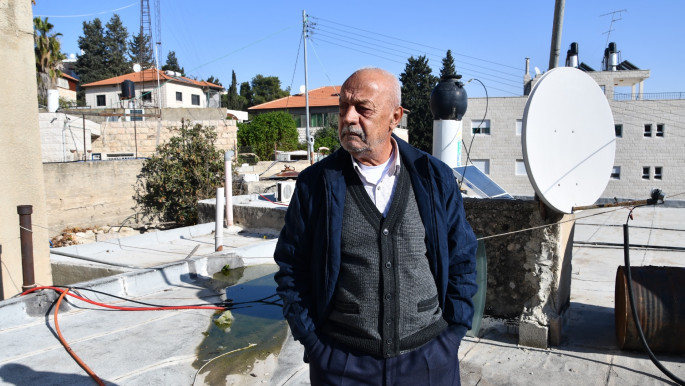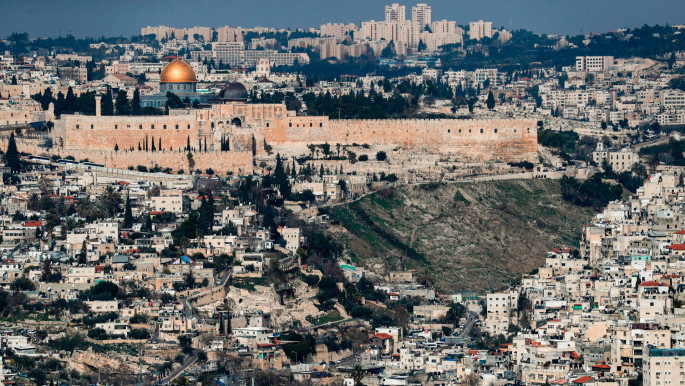Israel's demographic battle for Jerusalem leaves Palestinians struggling to survive
Now, along with over 20 families in the East Jerusalem districts of Sheikh Jarrah and Silwan, he faces the possibility of homelessness in the new year after Israeli courts ruled in favour of Jewish settlers determined to expel them.
In November, a Jerusalem Magistrate's court ordered the Sabbagh family to vacate their home of more than 60 years and pay settler organisation Nahalat Shimon International 7,500 shekels (roughly £1,720) for legal expenses.
The family's lawyers were able to delay the eviction by securing an interim injunction. The Sabbagh family is now waiting to hear from the court on whether they can appeal the ruling. If the court rejects the appeal, the family will be forced to leave their property.
"I don't believe in the Israeli court," Sabbagh told The New Arab. "I know they will not stand by our side. They will stand by the other side and the eviction will happen."
According to one of Sabbagh's lawyers, Sami Ershaid, 13 families in Sheikh Jarrah - including the Sabbagh family - face eviction. Seven of these families have filed appeals to recent court decisions while the other five families are still battling their eviction orders in the district court.
 |
It's one part of a bigger puzzle of a colonial system that is evicting and displacing Palestinians |  |
"What will happen to my family will happen to the seven families. My family is 32 people," Sabbagh said. "With the seven families, it's more than 100 people." Additionally, 11 families in Sheikh Jarrah have already been evicted.
In the Silwan neighbourhood of Batan al-Hawa, 12 families totalling 67 individuals face eviction. Since 2015, 14 families have been evicted. Batan al-Hawa resident Zuheir Rajabi has been embroiled in a legal battle with settler group Ateret Cohanim since 2015. His latest court hearing was scheduled for December but was postponed to April because of the coronavirus pandemic. Despite these delays, Rajabi isn't optimistic much will change with his case.
"There is no hope with the judges, because the judges themselves are settlers. They are extremists," Rajabi said. "One of the judges said to me once, 'I advise you to evacuate the building and receive your compensation because at the end I'm going to issue my order in favour of the settlers.'"
 |
|
| Mohammed Sabbagh looks out over Sheikh Jarrah from the rooftop of his home. [TNA/Jessica Buxbaum] |
Silwan is part of an area of Jerusalem known as the Holy Basin. The land is coveted by Jewish settlers because of its proximity to the Old City and alleged connections to King David. Establishing a homogenous Jewish centre in the Holy Basin is part of a larger effort to 'Judaize' Jerusalem, effectively erasing any possibility of a Palestinian capital in the city.
For Fayrouz Sharqawi, Global Mobilization Coordinator of Palestinian community organisation Grassroots Al-Quds, the details of each case aren't as important as the pattern of ethnic cleansing that is ongoing in Jerusalem. "It's one part of a bigger puzzle of a colonial system that is evicting and displacing Palestinians," Sharqawi said.
"It's not just legal cases of a few families that you can count and give a number. We're talking about 350,000 Palestinians living inside the municipal boundaries of Jerusalem who are facing evictions that come in different types and shapes and colours," she added.
"It's no different than the cases of Palestinian families whose homes are demolished on the grounds that they were built illegally. This is simply different faces of the same system, of the same machine that is uprooting Palestinians and has been since even before 1948."
 |
It's a continuation of the first Nakba. It's not happening randomly. It's a systemic thing meant to decrease the number of Palestinians in the Holy Land |  |
Becoming a refugee again
Sabbagh's family came to Jerusalem after fleeing Jaffa during the 1948 Nakba. His family - along with 27 other refugee families - moved into Sheikh Jarrah houses built by the Jordanian government in 1956.
Under an agreement between Jordan and UNRWA, the families received these homes (located on lands once leased to Jewish communities) in exchange for renouncing their refugee status with UNRWA. After three years, Jordan was supposed to provide the Palestinian families with ownership titles but never did.
 |
|
| Read more: Battle for Silwan: The Palestinian family fighting Israeli eviction in Jerusalem |
According to Rajabi, 90 percent of the families in Silwan are refugees. His family moved to Silwan after being evicted from the Jewish Quarter in the Old City in 1967.
During the 1948 war, around 2,000 Jews fled or were expelled from East Jerusalem and about 20,000 Palestinians fled or were forced from their homes in West Jerusalem.
Enacted in 1970, Israel's Legal and Administrative Matters Law was meant to restore these properties lost in 1948 - but exclusively to Jewish owners. Two groups of people were displaced in 1948, however today only the Jewish population has the legal right to return.
This law (and previously the Absentees Properties Law) are what settler associations like Ateret Cohanim, Nahalat Shimon and Elad use to sue and evict Palestinian residents under the pretence that Yemeni Jews owned the land prior to 1948 and therefore it belongs to them.
For Rajabi, what's happening with these evictions isn't something new. "It's a continuation of the first Nakba," Rajabi said. "It's not happening randomly. It's a systemic thing meant to decrease the number of Palestinians in the Holy Land."





 Follow the Middle East's top stories in English at The New Arab on Google News
Follow the Middle East's top stories in English at The New Arab on Google News


